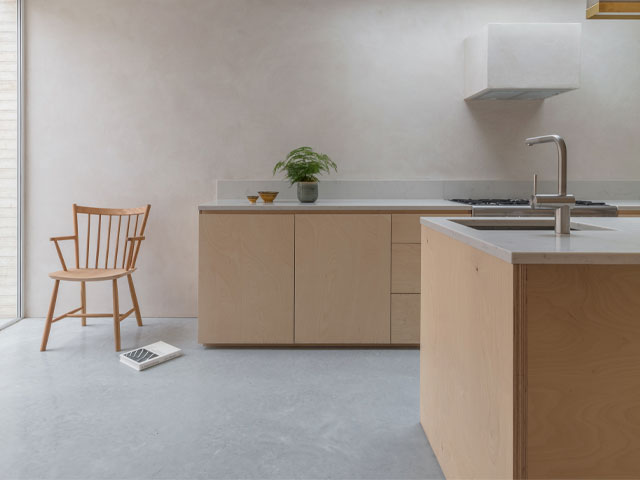15 eco-friendly wall and flooring options
Ideas for walls and flooring that look great, perform well and are kind to the planet
Looking for sustainable flooring and eco-friendly tile options? There are now more than ever, from sustainable cork flooring to FSC-certified hardwood and ceramic tiles made with recycled materials to boost your home renovation project’s eco-credentials.
1. Sustainable porcelain and ceramic tiles
Is porcelain tile sustainable? What about ceramic tile sustainability? The eco-credentials of hardwearing, low-maintenance porcelain and ceramic tile is boosted by ranges made with recycled materials. Try Alusid, Domus, Parkside and CTD Architectural Tiles. Pictured below: Three-D plain and relief ceramic matt wall tiles made from 62% recycled ceramic waste, 200x50mm, £48 per sqm, CTD Architectural Tiles (available via an architect or designer).

Photo: CTD Architectural Tiles
2. Recycled glass tiles
Recycled glass tiles are made using material otherwise destined for landfill and require less energy to manufacture than other tile types, making for a lower carbon footprint. Pictured below: Confiserie Blush Triangle mosaics, made with recycled glass, 280x280mm, £79.88 per sqm, Trousdale Terrazzo porcelain tiles, 600x600mm, £56.95 per sqm, Claybrook.

Photo: Claybrook
3. Recycled plastic wall panels
Wales-based firm, Smile Plastics uses 100% recycled and recyclable waste plastic to make wall panels and work surfaces – a great eco-friendly tile alternative. It operates zero-waste production and buy-back scheme for offcuts and end-of-life products. Pictured below: Alba panels made from recycled yoghurt pots, from £120 for a 500x500mm, 5mm thick splashback, Smile Plastics. Interior design by Indie & Co.

Photo: Smile Plastics / Indie & Co
4. Plastic-free natural paint
Natural paint is made using ingredients such as clay, minerals and natural pigments. It is plastic free, non-toxic, non-polluting and low VOC. Try brands such as Edward Bulmer, Graphenstone, and Bauwerk Colour. Pictured below: Lime Paint in Silversky, from £30 per litre, Bauwerk Colour.

Photo: Bauwerk Colour
5. Clay plaster
Clay plaster offers a beautiful depth of colour and texture. It is natural, non-toxic, and has zero emissions. The finish regulates humidity due to its moisture-absorbing properties, making it a great eco-friendly tile alternative for kitchen walls, and ceilings. Pictured below: Smooth Finish natural clay plaster in WHI0, £20 per sqm, Clayworks. Project by Architect Studio, Magri Williams.

Photo: Nicholas Worley
6. UK-made natural tiles
Help to cut your carbon footprint by choosing handcrafted tiles made as close to home as possible using natural and sustainable materials. Pictured below: Residence Manoir Mint Patchwork ceramic tiles, handmade in Devon, 129x129mm, £280.25 per sqm, The Winchester Tile Company.

Photo: The Winchester Tile Company
7. Timber terrazzo panels
If you want to add the character of terrazzo surfaces to your scheme, look for products made with recycled timber scraps, stone or glass chippings – and VOC-free resin binder. Pictured below: London Collection FSC-certified timber terrazzo panels in Bianco Mono, from £450 per sqm, Foresso. Project by Rise Design Studio.

Photo: Foresso / Rise Design Studio
8. Cork flooring and wall panels
Cork is a renewable bark that can be made into tiles and planks for floors and walls. Naturally anti-microbial and soft underfoot, it also dampens sound and helps retain heat. When sealed, it needs little maintenance, so you can even have sustainable cork flooring. Pictured below: Bespoke stained oak kitchen with Ceasarstone upstand and black stained cork wraparound panel, from £35,000, H Miller Bros.

Photo: Ceasarstone / H Miller Bros
9. Biodegradable linoleum
Linoleum is made from linseed oil, wood flour, pine resin and environmentally responsible dyes. It comes in a wide range of colours and can be cut to create decorative designs. Warm and durable underfoot, it is also biodegradable, making it a great sustainable flooring option. Pictured below: Grey and white linoleum, from £69.30 per sqm, and bespoke hand cutting service, Sinclair Till. Interior design by Smith Creative.

Photo: Sinclair Till / Smith Creative
















